This was our 4th consecutive year of exploring the various cultivars of Madeira. Having previously surveyed Terrantez, Verdelho and Boal grapes, the natural progression from dry to sweet, led us to the marvelous Malvasia grape. The perfect ambience, spacious banquet room, excellent food and service staff at NYC’s Del Posto restaurant, has continued to deliver on all cylinders so we were pleased to return to this fine establishment for this event. The selection of quintessential bottlings was seemingly more difficult this year, in part due to the fact that great old Malmsey is more prevalent than some of the other grape varieties, providing an abundance of old bottlings to choose from.

Article and photos by Roy Hersh © December 2015
While red wine enthusiasts and collectors in the US often start out with California Cabernet and may gradually further explore powerful wines such as Aussie Shiraz, Chateauneuf du Pape and Claret; as palates evolve, aficionados often gravitate to more intricate wines like Rioja, Barolo and/or Burgundy.
It is my belief that a similar dynamic occurs with Madeira. Consumers often initially approach Madeira from Malvasia’s suave style, rich and concentrated in its sweetness. Over time however, that early sweet tooth evolves and I’ve noticed that many long time Madeira devotees tend towards the drier spectrum of Madeira such as Sercial, Verdelho, and Terrantez. But regardless of dry or sweet, there is a lot to love in each type and as long as the wine is balanced, it will deliver extraordinary allure.
While my palate preference clearly tends toward the ethereal complexity delivered by the Terrantez grape, I can’t remember ever saying no to a fine bottle of Malmsey. While sweet, the best examples of the Malvasia grape always maintain a strong sense of acid balance too. And honestly, who doesn’t like to sit back and sip a rich and hedonistic glass of Malmsey after dinner or later at night?
Mannie Berk, renowned owner of The Rare Wine Company in Sonoma, is the finest source for old and ancient Madeira within the United States. But beyond bringing beautiful bottlings of great Madeira into the country, his encyclopedic knowledge of the history and wines of the island is arguably the most extensive in the world today. It was an extraordinary pleasure to collaborate with Mannie again, co-hosting another once-in-a-lifetime Madeira party for our guests.
The Majesty of Malvasia tasting took place on Saturday, April 11th 2015. We had a stellar lineup of 20 unique bottles, the youngest of which was bottled only a couple of months prior to our event, but was vinified in the vintage of 1882. Coincidentally, that was exactly a decade after the scourge of Phylloxera first ravaged the island’s vineyards. Mentioned here are some of the great Malvasia vintages that were featured in our flights based on their excellence and historic importance: a trio of 1880 and 1875s, and a dynamic duo from the phenomenal 1830 vintage, along with a rare pairing of Soleras from 1808. These special vintages made up half of our tasting.
The guests list comprised some of the world’s most notable Madeira collectors, from both sides of the pond, but mostly from the US and UK. Their bottles were shipped ahead of time to facilitate proper decanting of the “old-in-bottle” Madeiras; compared to others that were also from ancient vintages, but fully matured in cask then bottled far more recently. The “old-in-bottle” Madeiras were vinified and often bottled after a few decades developing in cask, (with exceptions that were bottled later) then spent their remaining years in demijohn, bottle, (or both) some for a century or more. The “old-in-bottle” contributions to the tasting required as much as a week, or slightly more, of decanting prior to the event so they could recover from their “bottle sickness”. Reintroducing oxygen, by leaving the wines in open decanters allowed the bottle funk to blow off and the Madeira to evolve over time, enabling aromatic and flavor components to regain expressiveness. Fortunately, provenance of the bottles was beyond reproach, but with bottles this old, there is never a guarantee how they’ll show.
Mannie and I arrived early Saturday morning in order to coordinate the final arrangements with Del Posto’s excellent management and service staff. The bottles were lined up and we also discussed the dinner wines that would follow the main event. First the placemats were set on the table, (thanks to Julian Wiseman’s creative wine placemat software: www.jdawiseman.com/placemat.html). Four hundred glasses were required for the Madeiras and the staff began arranging the glassware into their circles on the placemats, then pouring the contents of the Malvasias. Within minutes, the room smelled like liquefied toffee and as guests arrived, it was apparent they were eager to begin.
Given the two Soleras included in our lineup, it is difficult to pin down the exact age for those wines. However, it’s safe to say that these twenty Malvasia bottlings had an average age of more than 160 years per, with a combined age exceeding 3,200 years. We were grateful to experience such an exceptional lineup of historic and rare bottlings of Malvasia. It was time for us to be seated.

The Participants
- Justin Ashourian – Florida
- Mannie Berk – Connecticut
- Bob Cunningham – New York
- Paul Day – UK
- Marco DeFreitas – Connecticut
- Ricardo Diogo Freitas – Madeira
- Roy Hersh – Washington
- Eric Ifune – Nevada
- Stuart Leaf – New York
- Mark Lee – California
- Bob Maliner – Florida
- Richard Mayson – UK
- Kevin Mendik – Massachusetts
- Aaron Nix-Gomez – District of Columbia
- Steve Pollack – California
- Jens Quistgaard – Washington
- David Spriggs – California
- Bob Stern – Pennsylvania
- Ilya Strebulaev – California
- Edwin Vos – Netherlands
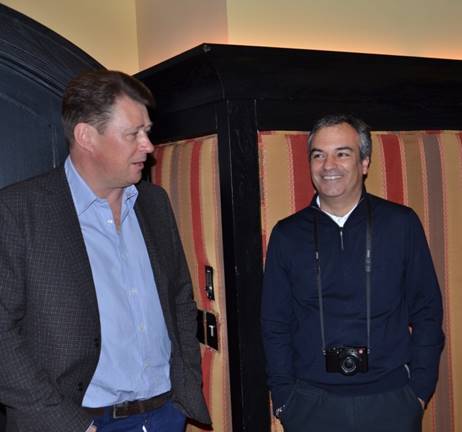
The following indented content was extracted from Madeira, the Islands and their Wines © by Richard Mayson; (with permission) published by Infinite Ideas earlier in 2015.
Malvasia / Malmsey
Undoubtedly the best known and most highly prized of all Madeira’s wines, the name ‘Malvasia’ (and its English corruption ‘Malmsey’) is in fact an umbrella for a number of different and probably unrelated grape varieties.
Historically, much the most sought after variety on Madeira is Malvasia Cândida. Recent DNA profiling has revealed that this is the same as Malvasia di Lipari, grown in Italy, Greece, Spain and Croatia. Its origin is uncertain but Malvasia Cândida was supposedly brought to Madeira from Crete (Candia) in the fifteenth century either by Venetian traders or, some say, by the Infante Dom Henrique (Prince Henry the Navigator) himself.
Malvasia (Cândida) has always been in very short supply. In 1530 an Italian named Giulio Landi stated that the Madeira produces a large quantity of wines of all kinds…as well as Malmsey, but in lesser quantities which is reputed to be better than that from Candia’. William Bolton, writing to a wine merchant in 1709 complains about the lack of Malmsey: ‘…we likewise observe yr (sic) order to us of 6 hogsheads of rich Malmsey, which, at present is not to be had in the whole island…’ During the boom years of the second half of the eighteenth century Francis Newton (erstwhile partner in Cossart Gordon) wrote frequently to his London partners lamenting the lack of Malvasia wine. In 1841, Paulo Perestrelo de Câmara wrote ‘...the best Malmsey grapes make only 200 pipes a year. This fabulous nectar, with its mellifluous flavour, has the pungent aroma of a posy of sweet-smelling flowers. This precious beverage is ready to drink after eight years, but is better left longer, but even only at a year old is agreeable, giving off its perfume and full flavour of the grape.’
Decimated by oidium and not widely replanted after phylloxera, by the mid-twentieth century Malvasia Cândida was almost extinct. It is very difficult to grow with production varying alarmingly from year to year. My brother-in-law, Andrew Blandy, planted Malvasia Cândida at Quinta de Santa Luzia in Funchal in 2005 but found it so tetchy and difficult to grow that he regrafted it less than ten years later to Malvasia Fina (Boal). Malvasia Cândida is very prone to attack by oidium and needs a well-exposed site at low altitudes to flourish. It also needs to be trained on latadas (low pergolas) as it should be pruned with at least eight buds to produce a commercial crop. It is subject to apical growth with the flowering tending to be towards the end of the cane.
Traditionally Malvasia Cândida grapes were only picked when they began to shrivel or raisinize on the on the vine, so concentrating the natural sugars to produce the sweetest and most concentrated of wines. According to the most recent records only 4ha of Malvasia Cândida is currently grown on Madeira at Jardim do Mar and on Fajã dos Padres, both at sea level on the south side of the island, as well as in the Government’s experimental vineyards.
Nearly all madeira wine bottled under the name Malvasia / Malmsey is in fact made from a grape known locally as Malvasia de São Jorge. Until 2015 Malvasia de São Jorge was no more than ‘authorised’ by IVBAM (Instituto do Vinho, Bordado e Artesanato da Madeira) but under the legislation published on 13th February this year it has been promoted to ‘recommended’. Malvasia de São Jorge is a modern variety that was introduced from Bairrada by Professor Leão Ferreira de Almeida of the Estação Agronómica Nacional in Lisbon and came to be planted on Madeira from the late 1970s onwards. However no one seems to know its parentage. Named after the parish of São Jorge on the north side of the island, the area of production expanded rapidly in the replanting programme that took place from the 1990s onwards and there are now 36ha, mostly around Santana on the north coast. This productive variety nonetheless has its drawbacks as it is highly susceptible to bunch rot. But it is aromatic when young and generally well liked by all the shippers.
A number of other so-called ‘Malvasias’ have been found growing on Madeira. In his book Madeira, The Island Vineyard, Noel Cossart mentions the Malvasia Babosa (‘Lazy Malmsey’). This variety was supposedly introduced to Madeira by Genoese nobleman, Simon Accaioli in 1515 but it is not clear what this variety equates to, other than possibly a grape known just as ‘Babosa’ on the Portuguese mainland. It seems that this sub-variety no longer exists on the island although I once came across a mid-nineteenth century bottle labeled ‘Boal Babosa’. There is also Malvasia Fina (otherwise known as Boal/Bual), and Malvasia Roxa (‘Purple Malvasia’). In the winery it seems that no distinction has been made between the different types of Malvasia and, when it comes to vinifying the grapes, all the Malvasias are usually pressed and fermented together. Malmsey should therefore be thought of as a style of wine rather than a varietal.
Today’s Malvasia / Malmsey is officially defined by IVBAM as being a ‘dôce, sweet or rich’ which means having at least 100g/l of residual sugar. In the past however Malmsey wines have been made that were drier in style.

And now for a historical perspective of the Malvasia grape, by Aaron Nix-Gomez © Dec. 2015. Aaron is the author of Hogshead: A Wine Blog (https://hogsheadwine.wordpress.com/author/hogsheadwine/)
“Very rich and old”: Malmsey in America at the turn of the 19th century
Madeira’s location off the northwest coast of Africa made it a natural stopping point for ships that followed the trade winds and currents to the shores of the American colonies. In 1665 British trade negotiations required all European wines exported to America to travel on British ships destined from British ports. The wines of Madeira were exempted creating a healthy trade and widespread thirst for the wine in the colonies. Early shipping news illustrates the continuous arrival of ships and their cargo from Madeira. The wines of Madeira were so dominant in the American market that it is the only wine listed in the current price reports for Philadelphia and New York from the 1720s through the 1760s. Other wines from Portugal eventually made the lists in the 1780s but Madeira held its place both in volume and price.
Priced at £40 to £100 per pipe, the introductory price for Madeira was the same as the most expensive alternative wine. Advertisements, from Boston down to Savannah, detail the various types and ages of Madeira that were imported into America. Amongst the most expensive offerings was the “very rich and old” Malmsey. Whereas other types of Madeira were available by the pipe, Malmsey was produced in such small quantities that it was typically sold by the quarter-cask and occasionally the bottle.
Madeira was priced in a realm that only affluent Americans could afford. Amongst these men it was the wine of choice for the earliest Presidents, Congressmen, and Supreme Court justices. Madeira figured prominently in the lives of George Washington, Thomas Jefferson, and James Madison. All three men routinely sought the finest and oldest Madeira which they served both for private use and at the Presidential dining table.
These three purchased their Madeira together as well as separately. Their wines were ordered from merchants in America, from commercial agents in Europe, and directly from houses in Madeira. They continued to seek Madeira throughput the years when American went from being a British colony to an independent country. Despite their dedication to Madeira, Malmsey was purchased only a handful of times. Their correspondence show that even for these men, Malmsey could be hard to obtain.
The creation of the city of Washington was approved in 1790. During the years that the President’s House, now known as the White House, and the Capitol were under construction, Madeira in general could be purchased in nearby Georgetown and Alexandria, Virginia. The closest offerings of Malmsey first appear in 1791 up at Baltimore, Maryland. Malmsey was not advertised with any frequency until shortly after the first session of Congress was held in November, 1800. After which, Malmsey was typically on hand in Georgetown.
The occupation of the capital city brought in enough people that the local supply of Madeira was drained. One city merchant noted that “during the recess of Congress” he added a large stock of Madeira “some of which is of a very superior quality.” Of all the selections for one Madeira shipper, Malmsey was the only one to be listed without price; instead credit terms were offered based on age. Thomas Jefferson would eventually classify Malmsey at nearly twice the cost of the high-quality London Particular. Malmsey, rare and expensive, had found a market in Washington.
If the taste for Malmsey was brought in by elected officials it certainly could have developed both in Williamsburg, Virginia and Philadelphia, Pennsylvania. In both cities Malmsey was advertised as early as the mid-1760s. Indeed, while Thomas Jefferson was a law student in Williamsburg, he noted in 1773, that “Mrs. Wythe puts one tenth very rich superfine Malmsey to a dry Madeira, and makes a fine wine.” In a later classification of the “different flavors or characters of wines” he labeled this blend as “silky Madeira”. It soon became more difficult to make Mrs. Wythe’s blend as a ban on the importation of Madeira into America went into effect in December 1774 shortly before the outbreak of the American Revolutionary War and lasted until the end.
Thomas Jefferson maintained his specific interest in Malmsey after the war ended. In 1786, while Minister Plenipotentiary in Paris, he ordered “very good Malvoisie de Madeira” or Malmsey, through a French firm. Only part of the order arrived so Thomas Jefferson requested the remaining be sent. As if to make up for the short-coming, an even larger amount was arrived. Incredibly, most of the extra Malmsey came from New York. Half of this order was intended for the Marquis de Lafayette. This particular pipe of Malmsey, noted as Madeira “de l’Amerique” in a memo to Lafayette’s secretary, was selected by Francis Lewis. Francis Lewis wrote to Thomas Jefferson in the spring of 1786 how he picked the best of 40 pipes and that it was eight years old.
The Malmsey of Jefferson and Lafayette then was from the 1778 vintage. This post-Independence vintage was most likely imported into New York sometime after the end of the Revolutionary War. The war had disrupted the importation of Madeira into America making the availability of “choice Old Madeira Wine … exceedingly Scarce & Dear”.
There were just over one dozen advertisements for Madeira in the newspapers of Maryland and Virginia during 1782. There was more than ten times that amount in 1786. The thirst for Madeira which existed during the Colonial years had survived the difficulties of war.
Thomas Jefferson wrote from Paris that it was “impossible to get good and genuine Madeira wine” in the city. Malmsey was in general a scarce wine. Thomas Jefferson’s difficulty in obtaining it Paris was undoubtedly increased by the very “short” vintage of 1784 which was followed by the total “failure” for Malmsey of the 1785, 1786, and 1787 vintages.
The very same year that Jefferson imported his Malvoisie, George Washington requested vines slips of the “best eating Grape” from Madeira for planting at his Mount Vernon home in Virginia. What he received included a barrel of “Fine malmsey Grape” slips which did not survive the long ocean voyage. George Washington also ordered Madeira that year but was so surprised by the post-war expense that he wrote, “I have not yet tasted it, but presume it is fine: it ought to be so, for the cost of it”. The Madeira shipper explained that the British factory had raised the price of “first quality” pipes by 10% in response to the small and “not very generally good” vintage of 1784.
Madeira remained the favorite wine throughout James Madison’s life. To meet one particular order of Madeira he was shipped seven year old Sercial, “Terita or Burgundy Madeira”, and Malmsey. These wines were scarce and shipped in quarter-casks as a result. Though several letters are missing it appears that James Madison enjoyed the Malmsey so much that he placed another order. Unfortunately “not a drop of that description” could be found on the island and of the scarce wines he was just sent another quarter cask of Sercial from the personal cellar of Don Joao de Carvalhal. Regarded as the richest man on the island with the best plantations, it appears that even Don Carvalhal did not have any Malmsey.
Many guests of Washington, Jefferson, and Madison wrote in their diaries about the fine taste of these rare and old bottles. George Washington even designed such special coolers to hold his Madeira that they had to be made in London. James Madison also served his Madeira in coolers. On the evening of the Burning of Washington, during the War of 1812, the occupying British forces found his “super-Excellent Madeira” cooling in the Presidential dining room. The British drank this Madeira before torching the President’s House. Though the Presidential cellar was destroyed, the rest of James Madison’s wines were safe at Montpelier including a parcel of Madeira he had ordered together with George Washington known as his “Washington Wine”. James Madison’s habits of long aging, storage in a warm area, and naming of a parcel were soon to become the hallmarks of the great 19th century Madeira connoisseurs of the South and the North.
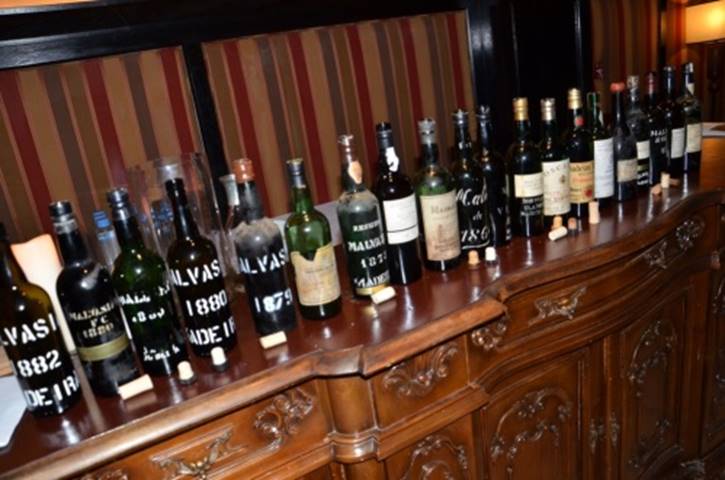
Please note: There is a detailed historical perspective of each wine by Mannie Berk (MB), which will precede my tasting notes included below (RH).
FLIGHT 1
MB: 1882 Barbeito Malvasia “RR” – According to Ricardo Freitas, the Malvasia vineyards that produced this wine were in Estreito Câmara de Lobos. The Count of Ribeiro Real (1841-1902) was the first owner of the property, which was known by the same name. The Count did not have any sons and left 4 hectares of land, as a token of friendship, to the Favila Vieira family. Counselor Manuel José Vieira, lawyer and politician, also had grapes and wine production in his other properties of Santo Antonio, Ajuda nos Piornais and Vinha Velha Nazaré (this last one located in São Martinho). In addition to the land, the Count left Counselor Vieira this 1882 Malvasia, still in cask. Vieira, who kept the 1882 aging in old casks, is known to have said to his friends: “The biggest patrimonies I leave to my family are the old wines.” From Counselor Vieira the wine passed to Professor Angelo Augusto da Silva, the director of the High School in Funchal. The wine was then moved into demijohns and kept in a cellar in the Rua da Carreira until February 24th 2015, when it was bottled by decision of its owner, Mrs. Maria João Favila Vieira. A total of 177 bottles were bottled, of which 24 were kept by the Favila Vieira family.
RH: 1882 Barbeito Malvasia “RR” Madeira – The “RR” was the Count of Ribeiro Real, who owned the vineyards in Câmara de Lobos from which this wine was born. 177 bottles were filled from demijohn in February 2015, six weeks before our tasting. Two dozen bottles were held back by the Favila Vieira family). This bottle was only opened 24 hours prior to service. The color of the 1882 was a medium orange-amber hue with a golden meniscus. A fine beginning to our tasting as this Barbeito elicited swirling scents of lifted saline, lemon grass, vanilla bean, mahogany, gingerbread and loads of toffee. Medium weight, the first flavor to come to the fore was dry lemon peel, followed by a scoach of VA, along with prominent cedar and prune. Soft and silky, the vibrancy from the acid delivered a sense of freshness and balance. If this had been decanted for another two days, I believe it would have shown more depth and greater length. The finish was medium length and with an aftertaste of sweet ripe peach. Overall, this Malvasia seemed on the dry side of Boal’s spectrum but was delicious. 92 points 4/11/15
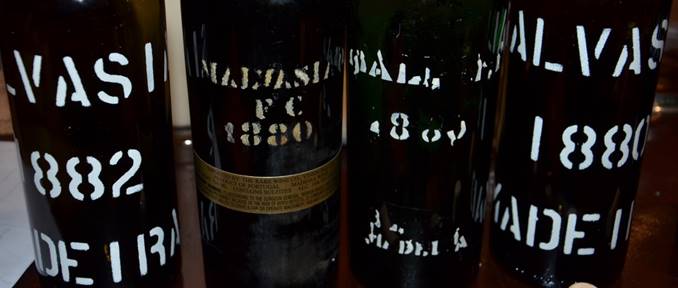
MB: 1880 FC Malvasia – According to Patrick Grubb, this was bottled in 1955 "when almost a liqueur." Rebottled and aired circa 2010. FC stands for Francisco Costa, the wine’s owner.
RH: 1880 FC Malvasia Madeira – Bottled in 1955, rebottled around 2010. FC = Francisco Costa. This spent over 8 days in decanter. Slightly darker orange color with golden-green edge. Austere early on, but lots of coaxing allowed the aromatics to slowly emerge, proffering light scents of walnut skin, torched sugar, white peach and coffee bean with a smidge of VA. Presenting a rich, sweet entry and lightly layered mid-section, with chewy and seductive flavors of golden raisins, candied praline and unctuous marmalade with adequate acidity. Not the most complex wine and there seemed to be a bit of reduction in the bottle. The 1880 gained weight over several hours in the glass and delivered a prolonged finish, (initially a bitter edge that didn’t last). 90 points 4/11/15
MB: 1880 Blandy’s Malvasia – Stenciled bottle. Metal Blandy's capsule. Eighteen eighty is a famous Malvasia vintage, though, as is usually the case, it's hard to say which of the various surviving 1880 Malvasias may share a common origin. Of Cossart-Gordon's 1880 Malmsey, Noël Cossart wrote that it belonged to the famous collector Stephen Gaselee, who had acquired through either Noël's father or Harry Hinton. Noël called it a great wine that came "from the best Malvasia vineyards" and "was kept in wood for 75 years before being bottled ... a great luscious pungent wine with fine lingering sweetness." According to Noël, Avery's Malvasia Frasqueira Particular also was outstanding (implying that it may have been the same wine). The Avery's wine sold in 1962 off their list for less than $8 a 12 malvasia book e_Layout 1 4/3/2015 2:03 PM Page 12 bottle. According to Noël, both Blandy's and Cossart had 1880 Malvasia on their lists in the 1950s, without noting whether or not they were the same wine. Blandy's was offering their version at least as late as 1976.
RH: 1880 Blandy’s Malvasia Madeira – Dark caramel center with a tawny-amber rim, the darkest optic of the first flight. Lovely tropical essence of coconut, nectarine along with a roasted espresso bean note and crème anglaise. This 1880 is a heavy weight contender with a sublime velvety texture and solid core of acidity, a real pleasure to roll around the mouth. The mélange of macadamia nut, ripe tropical fruit, chutney and a char character persists through a long, rich and seamless finish. 94 points 4/11/15
MB: 1880 Barbeito Malvasia “MMV” – Bottled from a single demijohn in 2014, 37 bottles were produced in total. The remainder was used for Ricardo’s superb 40-year old “Mae Manuela” Malvasia, made as a tribute to his mother in 2013. Ricardo believes that this wine probably came from either the Hinton or Favila Vieira families.
RH: 1880 Barbeito Malvasia “MMV” Madeira – In May 2014, while visiting Ricardo in Madeira, he shared this 1880 and it was one of the finest Madeiras I’ve tasted. Maple toned with ruby glints at the center and lime green meniscus. It possessed a stunningly complex perfume of grapefruit and lime peel, smoky and nutty scents, purity of esteva and a lifted whiff of petrol. Medium rich and framed by piercing acidity that cleaved the sweetness of desiccated fig and sultana. Textually smooth falls way short as a descriptor; while the vibrancy and intensity of MMV’s lingering aftertaste is simply smashing. That being said, the bottle we tried last year, presented even better. 97 points 4/11/15
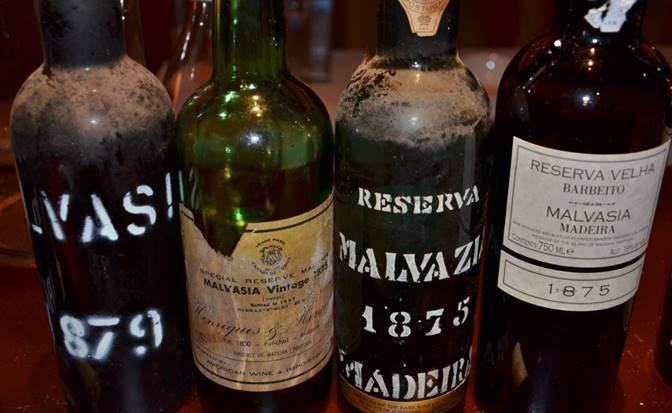
FLIGHT 2
MB: 1879 Herdeiros Dr. Castro Jorge Malvasia – From the heirs of Jorge Castro. Bottled in 1943; recently recorked and rewaxed. This wine was from the inheritance of Joao Martins da Silva, 1860-1940, a ship owner and founder of the Madeira Navigation Agency.
RH: 1879 Herdeiros Dr. Castro Jorge Malvasia Madeira – Bottled 1943; recorked and waxed recently. Light caramel color with a tawny edge and cloudy appearance. Accents of cinnamon stick and baking spice, green apples, earthy and saddle leather notes prevail. Others found this more intriguing to their tastes. Simple and pleasant, with apple cider sweetness, golden raisin and vanilla cream flavors with a dollop of mandarin orange. Round, slightly hollow mid-palate that was propped up by racy acidity. Soft and juicy, with an orange / walnut combo closing out the modest finish. It was slightly better than this reads, but was a bit of a letdown after the prior wine. 88 points 4/11/15
MB: 1875 Henriques & Henriques Special Reserve Malvasia – Very rare. Only two bottles known in Cossart's 2nd Edition to have been sold at auction, and this was in 1980s. Bottled 1957.
RH: 1875 Henriques & Henriques Special Reserve Malvasia Madeira – Bottled 1957. As 1875 is known as one of the fine vintages for Malvasia, the rarity of this H&H bottling increased anticipation, momentarily. The Special Reserve presented the darkest color of any of the 20, with a molasses brown hue, opaque at its core and fading to a broad golden edge. Initially, the nose was reticent and required lots of swirling to unwind sweet whiffs of marzipan and butterscotch followed by a funky roasted note that I couldn’t quite discern. The RS was extreme, delivering nearly teeth chattering sweetness and barely enough acidity to avert a sense of cloying; not aided by the wine’s sheer thickness. Four square throughout, the light flavors of simple syrup, tobacco, toffee and tropical fruit were pleasant enough, leading to a medium length finish. 84 points 4/11/15
MB: 1875 D’Oliveira Malvasia – An older bottling from the 1970s. This wine continues to be available from D'Oliveira, along with two other 1875 vintage Madeiras: Sercial and Moscatel.
RH: 1875 D’Oliveiras Malvasia Madeira – Bottled in either 1978 or 1979 and recently rebottled. Medium-dark maple color with a greenish-amber rim. Exhibiting an excellent array of salted caramel, white peach, iodine, clove, golden raisin and lifted highlights of VA. The palate is equally enthralling with full throttle notes of crème brûlée, a fine mix of sweet overripe pineapple and peach along with tart key lime and a variety of concentrated torrefacted flavors. It’s velvety and opulent across the tongue and blessed with precision driven acidity. The symmetry and level of intricacy here puts this Malvasia squarely in the upper echelon of its peers, from this grape. The fact that it remains readily available today is a huge bonus for consumers. 96 points 4/11/15
MB: 1875 Barbeito Malvasia – Phylloxera was first identified in Madeira in 1872 and from that point on, production declined, but only gradually, as the vine louse spread. Therefore, it is not surprising that high-quality Madeira continued to be made in years like 1875. According to Ricardo Freitas, this famous example from Barbeito was bought by Mario Barbeito from the Hinton family in 1946/47, when he founded his firm. It was one of the first old wines Barbeito owned. The wine was bought in a 620-liter cask, but now only about 75 liters remains, and it was all transferred to 60L demijohns in 2008. These demijohns are part of the private collection of Manuela Freitas. The grapes are believed to have come from Ribeira Brava, and may be from the same original source of as D'Oliveira's 1875.
RH: 1875 Barbeito Malvasia Madeira – Bottled in 2003 from wine in cask transferred to demijohns in 2008. Circa 75 liters remain in the private stock of MMV. The second darkest wine of the flight and more so than D’Oliveiras, with nearly full opacity at the center and a narrow gold band. It was wonderful to compare these two excellent Madeira shippers’ Malvasias side-by-side again. It’s always an educational pleasure and privilege to do so. A deep smoky-char note comes to the fore and is adorned by scents of cinnamon, sweet glove leather, pecan, peach marmalade and sea mist. There is a seamless sense of harmony that this Barbeito exemplifies. Likely it is due to the combined vibrancy of the acid and the depth of the mid-palate and intensity of the finish. The flavors are sweet and lingering with fresh orange creamsicle, nectarine and praline, in a viscous body framed by a sophisticated lightness of being on the finish. ‘Tis a very fine drink, indeed! 94 points 4/11/15
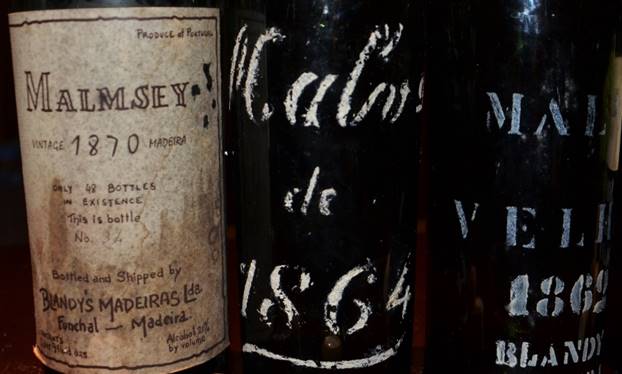

FLIGHT 3
MB: 1870 Blandy’s Malmsey Reserve – Generously donated to the tasting by Eric. One of a series of Blandy's releases from the 1960s with front and back brown paper labels. According to the label only 48 bottles were produced, of which this is bottle 34, and the wine "was acquired from D. Maria Favila Vieira, a partner of this firm, who inherited this wine from her family." According to the Cossart 2nd edition, 13 bottles were identified as having been seen at auction between the 1990s and 2003.
RH: 1870 Blandy’s Malmsey Reserve Madeira – Bottle #34 of a total of 48 produced, we were very fortunate to have one in our tasting. Light-medium caramel color with a wide golden meniscus. A sexy wine with ostentatious bouquet of bees wax, iodine, Indian spices, honey, black tea, acacia flowers, seaside marsh land and savory aromatics. An incredible nose that continued to morph over several hours. The palate was up to the challenge and provided deeply concentrated and multi-faceted flavors of rich, chewy dried fig and apricots, tobacco, cashew and mulled apple cider. Exotic and seamless juice, with precision and cut; my only quibble being the middling length of the finish, otherwise this Malmsey would’ve been in another realm. A completely unexpected “one off tasting” that will add to the other memorable 1870 Blandy’s Madeira experiences from both Verdelho and Terrantez grapes. The Malvasia was a very worthy companion. 94 points 4/11/15
MB: 1864 Barros e Sousa Malvasia Fajã – According to Madeira Wine Guide, the company of Artur de Barros e Sousa, Lda., was founded in 1921. No other brands or companies are associated. The company is today owned by the Olim brothers, Artur and Edmundo, descendants of the company’s founder (fourth generation). No known auction sightings prior to the Christies London sale at which this bottle was purchased in December 2013. Please note however the wine was catalogued as Blandy’s.
RH: 1864 Barros e Sousa Malvasia “Fajã” Madeira – The Olim brothers sold the company to their next door neighbor, Luis D’Oliveira a couple of years ago, as they had no heirs willing to run the business. A sad day for this great family with lots of fine bottles; but the real treasure was their many casks left aging in the adega’s canteiro rooms. Fortunately, their “liquid assets” wound up in excellent hands and not some multi-national beverage concern that wouldn’t have appreciated their acquisition.
The source for this wine’s Malvasia Candida grapes is believed to have originated from the island’s most renowned vineyard, Fajã dos Padres, on the southern coast. Medium dark maple optic with hints of ruby at the center and a tawny-gold rim. A dark brooding nose of mahogany and medicinal notes initially gave way to scents of ocean-breeze salinity, dried dates and white flowers. Freshness emerged as the palate improved over the nearly six hours of our tasting. Unctuous and balanced with cleansing acidity, flavors included mandarin orange, hazelnut, grapefruit and prune, delivering a bitter-sweet silhouette that divided opinions of other tasters. The finish was drier than the entry (which was subtly sweet) the ending of medium length was absolutely delicious. 92 points 4/11/15
MB: 1862 Blandy’s Malvasia Velha – Stenciled bottle; plain wax capsule. It appears that the words "Malvasia Velha" were painted at a different time from "1862 Blandy Madeira." Twenty-two bottles seen at auction between the 1970s and 2006. "Velha," of course is "old" in Portuguese.
RH: 1862 Blandy’s Malvasia “Velha” Madeira – 1862 was a fantastic vintage on the island and many great wines were vinified that year. Not as well known for Malmsey, but I thought this had the potential to be a real surprise. It is a fairly scarce bottling and in short supply these days. It offered a medium cola-brown color with a wide golden edge. The aromatics seemed simple, but are not your typical Malvasia impressions: granny smith apple, Thin Mints, Medjool date, along with overtones of herbs, band-aid and VA. This Blandy’s was a rich, smooth and concentrated wine that lacked a real sense of complexity, yet still offered very compelling flavors. The simplicity stemmed from the very light nature of the acid which was present in the background, but kept this Madeira tame if not slightly dull. Nonetheless, the texture was magnificent, silky smooth and ultra-rich and was one for the highlight reels. The flavors ranged from ripe Seckle pear, a hint of roasted coffee, English toffee and hazelnut. Overall this Blandy’s Malvasia was very sweet upon entry and was just shy of being flabby. I tend to be a bit more critical of Madeiras that are either acid deficient or lack enough of it to provide the requisite balance. While this bottling was still quite tasty and enjoyable, I would have liked a bit more persistence in the finish, which was not only shorter than expected, it was also a bit too hot. 89 points 4/11/15
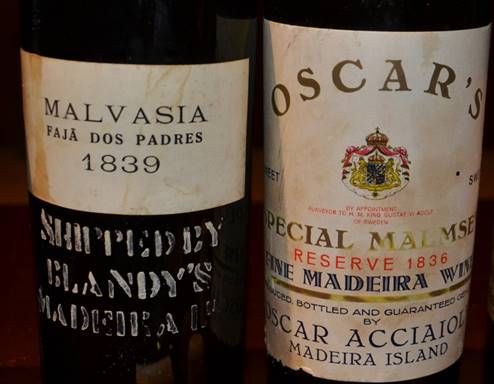
FLIGHT 4
MB: 1839 Blandy’s Malvasia Fajã dos Padres – This bottle was stenciled "Shipped by Blandy's Madeira Lda" with a plain Madeira Wine Association label. Unbranded gold metal capsule. Based on this wine, Alex Liddell wrote: "It is easy to understand why the Fajã had its reputation, and deserved it was.” Extremely rare, few bottles have ever appeared at auction or otherwise.
RH: 1839 Blandy’s Malvasia Fajã dos Padres Madeira – When you take a historic producer like Blandy’s and combine ancient Malvasia Candida grapes from the island’s best vineyard; amazing things can occur. Medium-dark tawny color, slightly cloudy with a golden rim. The distinctive bouquet morphed in a time elapsed manner and delivered the most exotic profile of the day with aromas of honeysuckle, dried apricot, vanilla bean, ginger, honey, quince paste, date ‘n nut bread, camphor and mahogany. Impressive! Medium-bodied, with all components contributing to the excellent equilibrium of this hedonistic 1839, especially the exacting and mouthwatering acidity. The vivid and lip smacking sweet flavors of caramel, velvety Frangelico, clove, spice and citrus melded with liquid butterscotch, leading to a layered finish of admirable persistence that literally lingered for minutes. At the end of our event, this won the “Malvasia of the tasting” with 13 of 20 first place votes. 98 points 4/11/15
MB: 1836 Acciaioly Malmsey Special Reserve – Oscar Acciaioly represented the last generation on the island of one of Madeira’s oldest families. Descended from the Dukes of Burgundy with an illustrious history in Florence, Italy, the Acciaiolys arrived in Madeira in the early 1500s and by legend were responsible for bringing the Malvasia Babosa grape to the island. When Acciaioly died in 1979, his remaining wines were divided into two parts. One part went to his second wife, who in turn sold them to Mario Barbeito. The second part went to his sons Michael and David, who consigned them, in their original state with original labels, capsules and corks, to Christie’s in London. The sons’ wines were offered at several sales, but principally on July 15, 1989, when 135 lots of old Acciaioly Madeiras kicked off the morning session at Christie’s on King Street. The sale included more than 170 bottles of 1836 Malmsey Special Reserve. The largest lot, containing 36 bottles of 1836 Malmsey, sold for about $140 a bottle. 14 Oscar Acciaioly in 1921.
RH: 1836 Acciaioly Malmsey Special Reserve Madeira – One of the greatest old Madeira producers that only serious Madeira enthusiasts are typically aware of. So many extraordinary wines were produced by this family over the years. Medium tawny color with an amber-greenish meniscus and some noticeable sediment. An expansive scented bouquet presenting notes of fig marmalade, VA, ripe pear, sea salt, raisin, honey and crème anglaise. Smooth as silk and uber-rich, the succulent spine of acidity cuts the sweetness and deftly provides near perfect balance. Loaded with tropical flavors of ripe pineapple and nectarines, toasted coconut, plus raisin and VA overtones that add an extra layer of complexity, this Acciaioly finishes with finesse and great length. 95 points 4/11/15
MB: 1830 H. M. Borges Malvasia – From 1877, when he began his firm, until his death in 1916, Henriques Menézes Borges was considered one of the great judges of old Madeira and acquired many legendary wines. A large number were passed down through the Borges family in demijohn and were finally bottled in 1989. Based on the 1989 bottling records, this wine does not appear to have been among them. Instead, it seems to have remained in the Borges company. Examples of 1820 Borges Malvasia exist with stenciled bottles, while the present example is fully dressed in a Borges paper label with matching neck label and capsule, but notably with no seal of guarantee, suggesting that it might have been released in the 1950s. We don't know whether the two bottlings are the same, but since Paul Day has tasted the stenciled wine previously, he may be able to tell us today whether he thinks they are or are not. No auction sales were recorded in the 2nd edition of Cossart of either bottling.
RH: 1830 H. M. Borges Malvasia Madeira – At a mere 185 years of age, this Malvasia is nearly a ghost in terms of any credible record of its existence, except that the Borges family does know that it was in their possession at one point in time. Otherwise? In this case, “The Mystery of Malvasia” prevails. The hung jury was split on this wine, some really liked it a lot and others not so much. Light caramel color with golden glints in the center and on the meniscus. There was a distinctive cider note intermixed with cinnamon and clove spiciness, caramel corn and tangerine. Voluptuous, round, smooth and creamy textured, it was fun to chew on this before swallowing, it was nearly that rich and would be fun to pour over pancakes. Sweet from entry to the swallow, a powerful Malvasia, concentrated in its wood-aged sophistication, with bracing acidity and a stopwatch worthy finish. Torn between 92 and 93 points, I opted for generosity. 93 points 4/11/15
MB: 1830 Quinta do Serrado Malvasia – Quinta do Serrado was the ancient estate of the Henriques family, situated in the heart of Câmara do Lobos. Wine was produced there for centuries, and on December 7, 1989, two of Serrado’s greatest wines were offered at Christie’s in London: an 1830 Malvasia and an 1827 Bual, each of which was said to have been demijohned in 1935 and bottled in 1988 for shipment to London. The number of bottles was dizzying: nearly 1,000 of each. Most of it sold that day, but the amount of wine was so great that a few dozen bottles lingered in a London warehouse for another seven years before finally being sold. Because of both the large amount of wine offered and the poor state of the old Madeira market at that time, the wines sold at low prices. Five and ten-case lots of 1830 Malvasia went for 600GBP per dozen bottles (including buyer’s premium). This Sterling price equated to $87 a bottle.
RH: 1830 Quinta do Serrado Malvasia Madeira – Formerly the quinta of the Henriques family, this Serrado was put in demijohn in 1935, bottled in 1988 and sold at Christie’s (UK) for $87 per. It was the 6th time tasting this wine and it’s always shown remarkably well. Today’s bottle conveyed a flamboyant fragrance that emerged after initially presenting a musty / skunky scent that was a concern, at first. Within an hour, the funk was gone and it cleaned up nicely, with a bouquet that included cigar box, maple bars, mahogany, light VA, treacle and roasted walnuts. The mid-section was intricately layered, viscous, poised and potent; and the acidity -- razor sharp, which I tend to love. But the single most captivating quality … the game changer here, was the sleek yet expansive and penetrating finish. The sweetness level was far more like a Boal (and could’ve possibly passed as a sweet version of Verdelho). Not the best bottle I’ve tried, but still a beauty. 95 points 4/11/15
MB: 1811 Malvasia Candida – In an old Burgundy or Champagne style bottle with a rust-colored wax capsule. Though nothing is clearly discernible on the top of the capsule, there is an impression that may have been from a JNV seal. Relatively long cork. The label reads: "Vinho de Malvazia / Bebe pouco / E viverais com alegria." Despite labeling differences, I believe this is the same wine as that tasted by Alex Liddell: "From a pri-vate island source. Old, machine- made green glass bottle. Labelled. 'P W' stenciled on bottle. Hard wax seal with JNV authentication seal superimposed. The most shriveled (relatively long) cork I have ever seen, not adhering to the sides of the neck, but kept in place by the wax seal. Heavy crusting. 13.4 per cent alcohol ...."
RH: 1811 Malvasia Candida Madeira – Cloudy appearance with a lot of sediment, and an amber-orange hue. Not a good sign as this stood out from the appearance of all other bottles. Odd notes of pine, lime leaves, apple cider, an herbaceous scent and a light whiff of maple. Light in weight and flavor, quite dry and delicate … just barely holding together and by the end of the tasting it had mostly fallen apart. Blind, I’d have guessed a fading 18th century Terrantez. What “fruit” was left seemed in the grapefruit realm with slight sweetness as in an under-ripe peach, but surprisingly good acidity remained. The finish was clipped and simple. No reason to kick a dog when it is down. Not rated 4/11/15
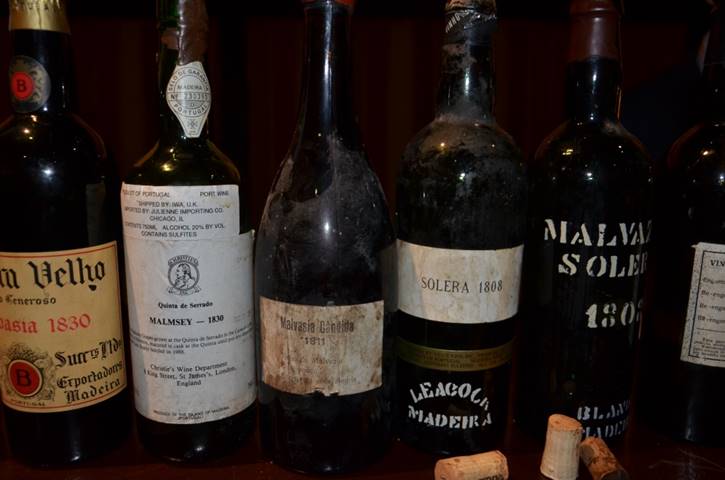
MB: 1808 Leacock Solera – Stenciled bottle with plain Madeira Wine Association label. This bottle came from William Leacock's collection, sold at Christies, London, December 11, 2008. The Leacock family’s bottles don’t indicate the grape variety, but this is probably at least based on the MWA’s 1808 Malmsey Solera.
RH: 1808 Leacock Solera Madeira – From William Leacock’s collection, sold at Christie’s (UK) on 12/11/08. Dark maple-tawny color, tinted with amber at the core and apple green edge -- and quite cloudy. Elusive swirling scents of dried date, golden raisin, toffee and loads of wintergreen, clove and VA. The aroma was the strong suit of this wine, lifted and bordering on ethereal with several high-toned characters present. It was extremely sweet on entry, the acidity nearly too sharp for me, which doesn’t happen often. Oddly enough, that polarity kept the wine in synch. Medium-bodied and while it is not easy for most people to detect a Solera, this 1808 was fairly distinctive in that regard. Tropical fruits, spiciness and toffee flavors prevailed with a dark essence of mahogany and walnut appearing late. The Leacock lacked a bit of freshness in spite of the acidity and left an impression of having remained in wood for many years. The dry finish was actually smooth, rich and of medium length. It’s an odd duck overall, but pleasant enough for a Solera, given its age. 90 points 4/11/15
MB: 1808 Blandy’s Malvasia Solera – Stenciled bottle with Madeira Wine Association wax capsule. The 1808 could be the most famous of Madeira Wine Association soleras, and Paul Day speculates there may have been as many as 15 different bottlings, each potentially different from the others. Unfortunately, we have little information on the origin of Blandy's 1808 Malvazia or Malmsey Solera, of which there are several examples, both labeled and stenciled. There's much more information available on Cossart-Gordon's, thanks to Noël Cossart, who called it "best ever known," writing that "the original madre of which had come from the Jesuit vineyard at Fajã dos Padre (and), was from grapes of the Malvasia candida variety. It became a solera in 1873 and was discontinued in 1955 because we could not find suitable Malmsey to top it up." He further noted that "the Malmsey vintaged in 1808 was a vintage until 1873, when it was founded as a solera and has been topped up ever since. The soleras are kept in the same casks that held the vintages to assure maintenance of character and style." But in 1962, Noël advised Roy Brady that the older bottlings of the 1808 Malmsey Solera were the best, and that the Avery's and Berry Brothers’ examples were of these bottlings.
RH: 1808 Blandy’s Malvasia Solera Madeira – How often do you get to try two Madeira Soleras back-to-back, that began more than two centuries ago? It was fun to compare both of these Malvasias, but after the first sip, the winner was apparent. Cola colored with an amber-greenish edge. While the nose of the Leacock would be impossible to beat, nonetheless, the more straight forward distinctive aromas of the Blandy’s was solid too, just not as wild and heady. Fine fragrances of shaved cedar and antique mahogany combined nicely with pure maple essence, cinnamon, saline and ripe pear. It offered a light-medium frame, with the caressing creamy texture of clarified butter. Structurally this was far more to my liking than the other 1808, with well-delineated crisp acidity providing tight-rope walker’s deft balance. While its sibling was all about that nose, the more refined combination of apple butter, sweet peach, salted caramel, hazelnut and unique nuance of botrytis-like sweetness; created significant separation from its competitor. The finish was delicious, but a little bit more length would have put this Solera in another league. 93 points 4/11/15
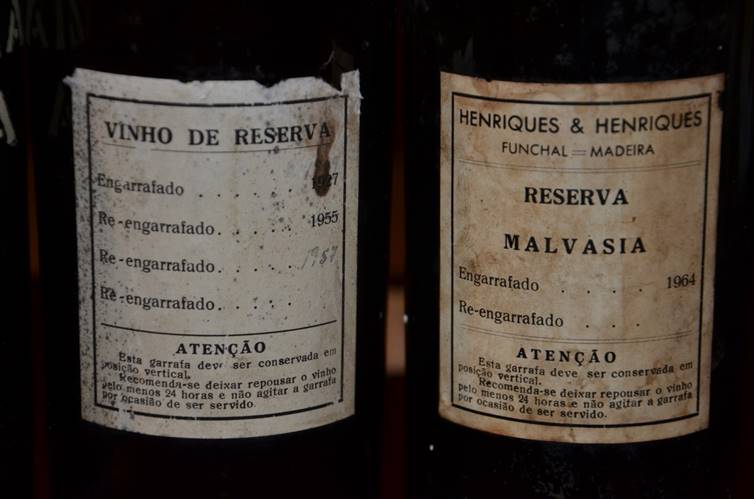
MB: Henriques & Henriques Malvasia Candida – Bottled 1939; rebottled 1957. This extremely rare bottle is from the estate of John Cossart. John had been managing director of Henriques & Henriques, and this bottle belonged to his father, Peter, who had preceded him. Though not mentioned by Liddell as a member of the Heavenly Quartet, the wine was almost certainly part of those early stocks of ancient H & H wines, though it was too rare to have survived in the company's inventory. Instead, like the Leacocks and Blandy’s at the Madeira Wine Association, Peter Cossart may have taken the few remaining bottles for himself, leaving them to John when he died in 1991, and then John to his children on his death in 2011. On John's death, the collection was sold to The Rare Wine Co. Most of the John Cossart collection was aired for several months in demijohn and then rebottled. However, because only a handful of bottles of this wine survived, they were not rebottled, but only recorked. It is one of the sweetest wines in John's collection, registering over 7 degrees baumé, compared to about 5.5 degrees for the Heavenly Quartet's famous Malvasia Reserva. Such high sugar was probably due not only to its Fajã dos Padres origins, but also to the Malvasia Candida grapes having been dried prior to crushing and fermentation.
RH: n/v Henriques & Henriques Malvasia Candida Madeira – Bottled 1939 and rebottled in 1957; from the estate of John Cossart, then sold by his sons to RWC. Fully transparent amber-maple hue with a straw-golden meniscus. A refined bouquet filled with disparate spicy accents of incense, white pepper, mint, honey, grilled pineapple, bees wax and sandalwood kept my nose in glass and eyes closed trying to sort out the shifting fragrances. It displayed an opulent mouthfeel and medium-body, sweet spicy flavors that closely echoed the aromatic personality. A sense of electricity from the acidic spine and elegance in the H&H was exemplified by the depth in the mid-section and long finish. 93 points 4/11/15
MB: Henriques & Henriques Malvasia Reserva – Bottled 1964. One of the undated Henriques & Henriques Heavenly Quartet, as celebrated by Alex Liddell in his book, Madeira. At the latest, these wines date from the early 1800s and therefore are certainly pre-Phylloxera. By reputation, they belonged to the company when it was founded in 1850., and enough bottles survived to remain on H & H's price list at least into the early 2000s. Alex called the H & H Malvasia Reserva "the quintessence of Malvasia and, for me, perfection."
RH: n/v Henriques & Henriques Malvasia Reserva Madeira – Bottled 1964, but vinified in the early part of the 19th century, before the founding of Henriques & Henriques in 1850. It is one of the venerable members of the H&H “Heavenly Quartet” as coined by Alex Liddell. To taste such an historic Malvasia to close out our tasting was a testament to the generosity of our participants. Dark molasses color with full opacity, albeit a bit cloudy from sediment, with a golden-greenish edge. The H&H presented a fully loaded arsenal of black truffle, creosote, mocha, pecan, singed caramel and sultana aromas. It’s a heavy weight, concentrated and richly textured, harmonious, edgy and graceful with exquisite acidity providing the verve and sense of a younger wine. Dark fruit flavors of fig and currant combine with brown sugar and stewed plums, ending with a seamless velvety and deliciously creamy butterscotch finish of fine length. 95 points 4/11/15
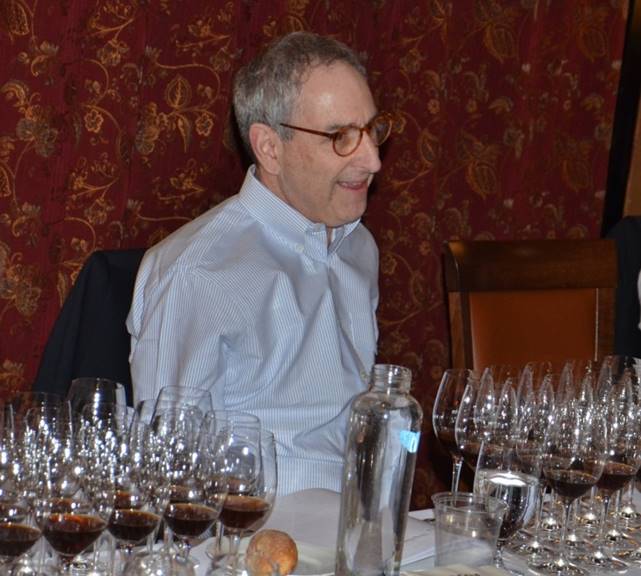
Mannie Berk

Leave A Comment
You must be logged in to post a comment.